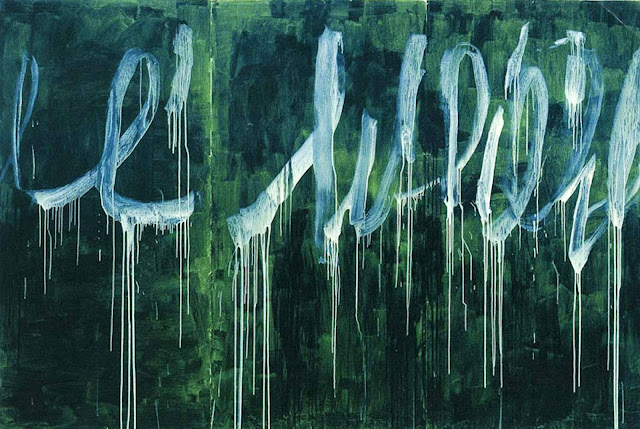Edwin Parker "Cy" Twombly, Jr. was an American artist well
known for his large-scale, freely scribbled, calligraphic-style graffiti
paintings, on solid fields of mostly gray, tan, or off-white colors. He
exhibited his paintings worldwide.
— From Wikipedia
Although his work resonates strongly with generations of younger artists, ranging from Brice Marden to Richard Prince to Tacita Dean to Patti Smith, it has a general propensity to polarise its audience between perplexity and unbridled admiration. (Remember the incident in summer 2007 of a woman planting a lipstick kiss on a Twombly canvas on show in Lyon?) Additionally, the critical and historical reception has seemed to describe two Twomblys – one about form, the other about content.
experimentation and exchange in a nation growing increasingly conservative during the Cold War. Among the influential teachers present at this time were Charles Olson, Franz Kline, Robert Motherwell and John Cage. Building on the freedom afforded by the previous generation, the younger artists emphasised libidinal energy integrated through experience.
From Claire Daigle ©
Twombly used the nickname "Cy", after his father (also nicknamed Cy) who was briefly a pitcher in Major League Baseball, and the star baseball pitcher Cy Young.[2] Twombly's paintings blur the line between drawing and painting. Many of his best-known paintings of the late 1960s are reminiscent of a school blackboard on which someone has practiced cursive "e"s. Twombly had at this point discarded painting figurative, representational subject-matter, citing the line or smudge – each mark with its own history – as its proper subject.
Later, many of his paintings and works on paper moved into "romantic symbolism", and their titles can be interpreted visually through shapes and forms and words. Twombly often quoted the poet Stéphane Mallarmé as well as many classical myths and allegories in his works. Examples of this are his Apollo and The Artist and a series of eight drawings consisting solely of inscriptions of the word "VIRGIL". In a 1994 retrospective, curator Kirk Varnedoe described Twombly's work as “influential among artists, discomfiting to many critics and truculently difficult not just for a broad public, but for sophisticated initiates of postwar art as well.”[3] After acquiring Twombly's Three Studies from the Temeraire (1998–99), the Director of the Art Gallery of New South Wales said, "sometimes people need a little bit of help in recognising a great work of art that might be a bit unfamiliar".[4] Twombly is said to have influenced younger artists such as Anselm Kiefer, Francesco Clemente, and Julian Schnabel.[5]
— From Wikipedia
On the 5th July 2011, Cy Twombly died in hospital in Rome at the age of 83.















No comments:
Post a Comment